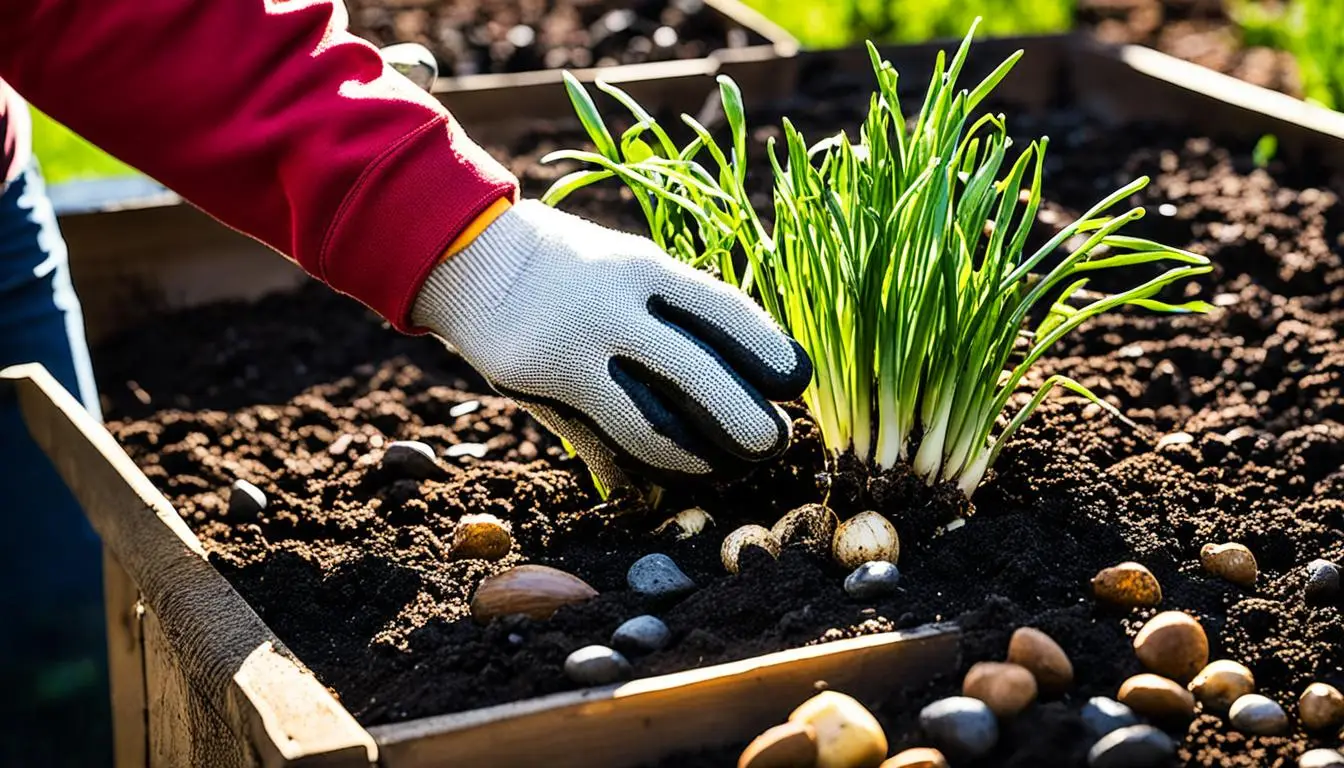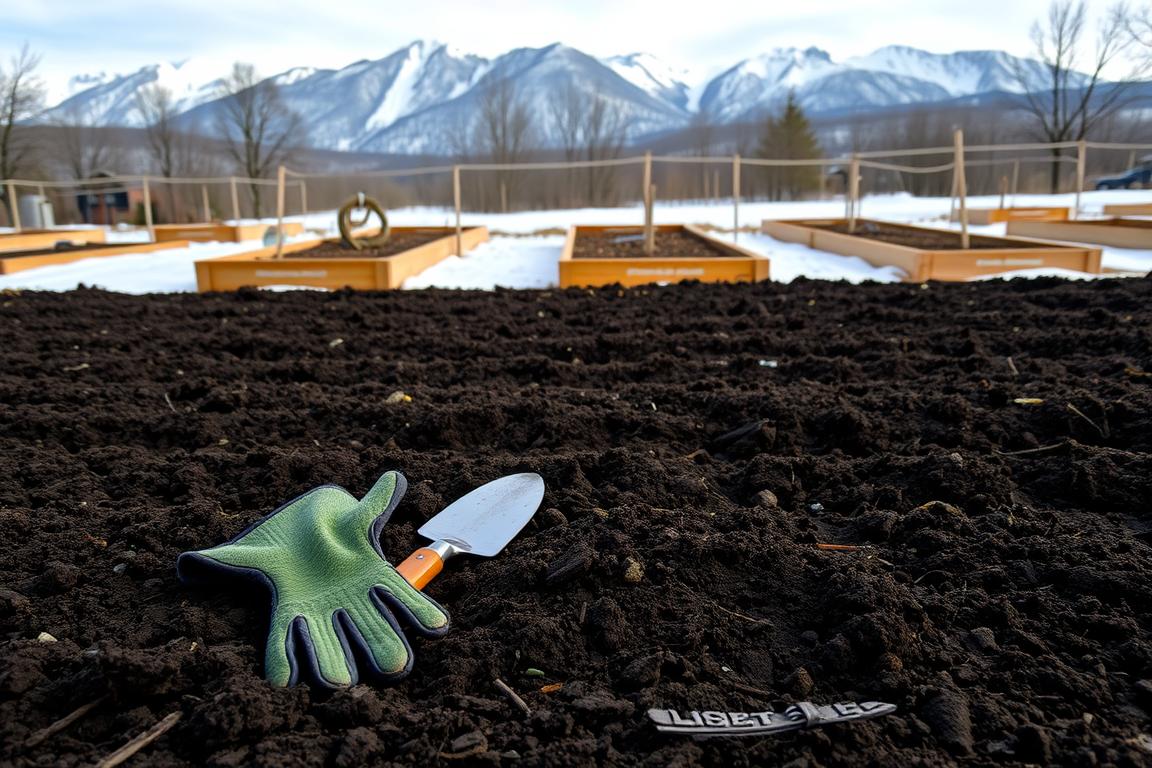Onions are great to grow because they bring a big harvest from a small space. They can also last for many months once harvested. Planting onions the right way is key to a good harvest. This guide will show you how to successfully plant onions, from choosing whether to use onion sets or seeds to soil prep, planting, caring for your crop, and finally harvesting and storing. With this advice, you can expect a lot of onions from your garden.
Key Takeaways
- Onions can be grown from sets or seeds, with sets offering a quicker and more reliable option.
- Well-draining, nutrient-rich soil is essential for growing healthy onion plants.
- Proper planting depth, spacing, and fertilization are crucial for optimal bulb development.
- Consistent moisture, weed control, and pest/disease management are important for ongoing onion care.
- Selecting the right onion variety for your growing region can make a big difference in yield and flavor.
Planting Onions: Seeds or Sets?
When you’re ready to grow onions, you can pick onion sets or onion seeds. Every choice has its benefits. Knowing these perks helps you choose wisely for your garden.
Advantages of Onion Sets
Folks who enjoy gardening often prefer onion sets. These are small onion bulbs already started. They grow fast, are more likely to succeed, and can handle some cold. In just 14 weeks, they become full-sized onions.
When choosing onion sets, go for those that are about 3/4 inch wide. Bigger sets might not do as well. They could end up with a hard center or go to seed too soon.
Starting from onions from seed is another good choice. Yet, the soil must be at least 50°F for the seeds to sprout. That means you need to start them inside before putting them in your garden.
Whatever method you pick, make sure you choose the right onion varieties for your area. There are types suited for different climates, like long-day or short-day onions.
Soil Preparation for Growing Onions
Getting your soil ready for onion growing is the first step to success. Onions love soil that’s well-draining and full of organic goodness. Mixing in some aged manure or compost makes the soil great for planting onions. This step also boosts the soil’s texture and fertility.
Improving Soil Quality
Preparing your onion bed means digging deep — about 6-8 inches. This depth allows onions to grow strong roots. Consider raising the beds or making rows. This setup helps with drainage, which is key for onions’ health. The right soil setup is essential for onions to thrive.
Choosing the Right Location
Onions need lots of sun to grow big and healthy. So, pick a spot that gets sunlight all day. Don’t plant near plants that could block the sun. Early on, in the fall or spring, prep your onion bed well. Remove rocks and debris to set up the best growing space.

How to Plant Onions
When to Plant Onions
Onions are best to plant in early spring. This is usually in late March or April. At this time, the chance of freezing is low.
For onions planted in spring, bury them 1-2 inches deep. Space them 4-6 inches apart. Rows should be 12-18 inches apart. Onions planted in fall need several weeks in warm weather to grow, before the cold stops their growth in winter.
Planting Depth and Spacing
It’s important not to plant onions too deep. This affects how well their bulbs grow.
Bury the sets between 1-2 inches deep. Space them 4-6 inches apart. Leave 12-18 inches between rows. This allows for good growth and lets air circulate around the plants.
Fertilizing Onion Plants
Adding nitrogen to the soil when planting helps onions grow big bulbs.
Some gardeners also put an inch of compost in the soil or dig trenches. This enriches the soil. It gives the onions the extra boost they need to thrive.
Caring for Onion Plants
To grow great onion plants, you need to care for them well. This involves regular watering, careful weeding, and keeping pests away. By doing this, you can make sure you get lots of onions when it’s harvest time.
Watering Onions
Onions like a steady amount of water, roughly 1 inch a week, which includes any rain. Their roots are shallow, and they don’t absorb water quickly. So, keeping the moisture consistent helps them grow well. This is even more important when they start forming bulbs, as it avoids them growing poorly or splitting.
Weed Control and Mulching
Keeping the area around onion plants weed-free is crucial. Weeds can take water and nutrients away from the onions. Mulching helps a lot. Spread 2-3 inches of straw between the rows. This keeps the soil moist, stops weeds, and lets air flow around the onions. Just remember to keep young bulbs lightly mulched to help them grow strong.
Pest and Disease Management
Onions deal with many pests, like thrips, onion maggots, and aphids. One way to keep thrips away is to plant onions near tomatoes or carrots. To stop onion maggots, cover the plants with netting once they’re coming up. And always watch out for diseases like purple blotch or downy mildew. If you see any signs, deal with them fast. Stopping pests and diseases early is the best way to keep your onion crop healthy.

Onion Varieties for Different Regions
Onions need different amounts of light to grow well. So, it’s important to pick the right kind for where you live. This ensures they grow big and healthy.
Long-Day Onion Varieties
‘Yellow Sweet Spanish’ and ‘Red Wethersfield’ like a lot of sun. They do the best in the north where there’s over 14 hours of daylight. For gardeners up north, these onions are a great choice for a good harvest.
Short-Day Onion Varieties
‘White Bermuda’ and ‘Red Burgundy’ do well in the south. They prefer having less than 12 hours of daylight. If you’re in a warm, southern spot, these onions will work perfectly for you.
Day-Neutral Onion Varieties
For those in between, ‘Candy’ and ‘Super Star’ onions are ideal. They aren’t picky about how much light they get. This makes them a smart pick for spots with changing daylight hours.
Harvesting and Storing Onions
Knowing the right time to harvest your onions is key. It ensures a successful crop and that your hard work pays off. Follow the best practices to make your onion harvesting effort rewarding and long-lasting.
Harvesting Onions at the Right Time
Onions are ready for onion harvesting when their tops turn yellow and flop over. This happens in mid-summer for onions planted in the spring. After this, loose the soil around the bulbs to help them dry.
Harvest them on a dry day and handle them gently. This prevents bruises, which can cause rot later. Once pulled, cut the roots and the tops down to 1-2 inches. If you want to braid them, leave the tops on.
Curing and Storing Onions
Onion curing is vital for storing onions long-term. Place them in a dry spot for a week or two. This allows their necks and skins to dry out. Once this is done, they can be stored in good condition.
After curing, you can hang the onions in mesh bags, store them in boxes, or braid them. Do this in a cool, dry place with good airflow. This way, your onion harvesting methods match the right onion harvesting season. This leads to top-quality onions that last a long time.
Conclusion
Growing onions is rewarding and not too hard for home gardeners. This article gives complete advice, from picking the right planting method to caring for your plants. It also covers choosing the right onion varieties, and how to harvest and store them properly. Following this guide, gardeners can expect a rich onion harvest. It doesn’t matter if you start with sets or seeds, onions can do well with the right care and conditions. They are a great crop that lasts a long time.
Even beginners can grow onions successfully with the right knowledge. It’s important to know how to prepare the soil and handle pests and diseases. By using the advice in this onion planting guide, you can make the most of this great-tasting vegetable.
If you’re experienced or just starting with onion gardening, this article is for you. With the right attitude, care, and a little bit of know-how, you can have a great onion harvest. Enjoy growing your onions from the beginning to the end.
FAQ
Q: What are the advantages of growing onions from sets versus seeds?
A: Onion sets, small onion bulbs, are better than seeds. They grow quickly and are more likely to succeed. Sets are fine against light frost and become full bulbs in 14 weeks. Pick sets about 3/4 inch wide to avoid stiff necks and seeding.
Q: What type of soil is best for growing onions?
A: The best soil for onions drains well, is loose, and rich in organics. Add aged manure or compost before planting. Onions like the full sun for large bulbs. Raised beds or mounds help with drainage, too.
Q: When is the best time to plant onions?
A: Plant onions in early spring, after the ground thaws and frost is not a worry. Usually, this is late March or April. Put the sets 1-2 inches deep, 4-6 inches away from each other.
Q: How do I care for onion plants?
A: Onions need about an inch of water weekly per square foot, counting rain. Mulch with straw to keep the soil moist and stop weeds. Plant onions next to tomatoes or carrots to repel thrips.
Cover your crop with mesh to keep out onion maggots.
Q: What are the different types of onion varieties?
A: Long-day onions like ‘Yellow Sweet Spanish’ do well where days are long, like the North. Short-day types, such as ‘White Bermuda’, prefer shorter days, like in the South. For in-between places, day-neutral onions like ‘Candy’ work best.
Q: How do I harvest and store onions?
A: Onions are ready when their tops start to fall over and yellow. Harvest them in the dry. Be gentle to keep them from getting bruised.
Cut the roots and leave 1-2 inches of the top. Let the onions dry for 7-10 days. This drying process helps them store well.






